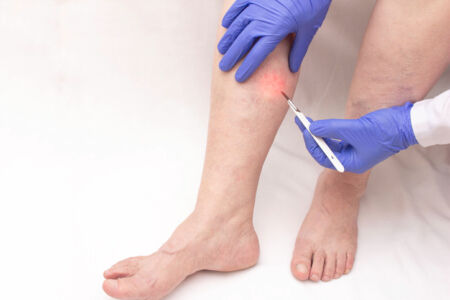
Laser Varicose Veins Surgery
Laser varicose veins surgery, also known as Endovenous Laser Therapy (EVLT), is a minimally invasive procedure used to treat varicose veins, which are swollen, twisted veins that often appear on the legs. Varicose veins are caused by weakened or damaged valves inside the veins, leading to poor blood circulation. This condition is common and can cause discomfort, pain, swelling, and, in severe cases, complications like ulcers or blood clots.
How Laser Varicose Vein Surgery Works
In laser varicose veins surgery, a laser fiber is inserted into the affected vein using a thin catheter. The procedure is performed under local anesthesia, and it is minimally invasive, meaning only small incisions are needed. The laser emits energy in the form of light, which heats the vein wall and causes it to collapse and seal shut. Once the vein is sealed, the blood is rerouted to healthier veins, and the treated vein is gradually absorbed by the body over time.
Key Steps in the Laser Varicose Vein Procedure
-
Consultation and Evaluation: The patient undergoes an evaluation to determine the severity and location of the varicose veins. A duplex ultrasound is often used to assess the veins and blood flow.
-
Local Anesthesia: The procedure is usually done under local anesthesia, meaning the patient remains awake but the area around the veins is numbed.
-
Insertion of the Catheter: A small incision is made near the vein, through which the catheter containing the laser fiber is inserted. The catheter is carefully guided to the problematic vein using ultrasound imaging.
-
Laser Activation: The laser fiber is activated, and the laser energy is delivered directly to the vein, causing it to collapse and seal shut.
-
Closure of the Incision: Once the vein is sealed, the catheter is removed, and the small incision is closed, typically with adhesive or a bandage.
-
Post-Procedure Care: After the procedure, the patient may be asked to wear compression stockings to help with circulation and reduce swelling. There might be some minor bruising or swelling in the treated area, but this typically resolves within a few weeks.
Advantages of Laser Varicose Vein Surgery
-
Minimally Invasive: The procedure requires only small incisions, which reduces the risk of infection, scarring, and recovery time compared to traditional surgery.
-
Effective and Permanent Results: Laser therapy seals the vein shut, and once the vein is closed, blood naturally reroutes to healthier veins. The results are typically permanent, though new varicose veins can develop over time.
-
Quick Recovery: Most patients can return to their normal activities within a few days. The procedure has minimal downtime, and the recovery process is much faster than that of traditional surgery.
-
Local Anesthesia: Unlike traditional surgery, which may require general anesthesia, laser vein surgery is performed with local anesthesia, which carries fewer risks.
-
Minimal Pain: The procedure is generally well-tolerated, with minimal discomfort. Post-procedure pain is usually mild and can be managed with over-the-counter pain relievers.
-
No Hospital Stay Required: Laser varicose vein surgery is an outpatient procedure, meaning patients can go home the same day.
Risks and Considerations
While laser varicose vein surgery is generally safe, like any medical procedure, it does carry some risks:
-
Temporary Side Effects: Patients may experience bruising, swelling, redness, or tenderness in the treated area. These side effects typically resolve within a few weeks.
-
Skin Burns or Nerve Injury: Rarely, the heat from the laser may cause burns or nerve injury if not properly controlled.
-
Recurrence of Varicose Veins: While the treated vein is sealed, new varicose veins may develop over time, requiring additional treatment.
-
Blood Clots: In rare cases, blood clots can form in the treated vein or the surrounding areas, leading to complications.
-
Infection: Though uncommon, there is a slight risk of infection at the incision site.
Who Is a Good Candidate for Laser Varicose Vein Surgery
Laser varicose vein surgery is suitable for most people with varicose veins, especially those who have:
- Large or bulging varicose veins that cause pain, swelling, or other symptoms.
- Inadequate or incompetent veins that no longer function properly, allowing blood to pool.
- A preference for a minimally invasive procedure over traditional vein stripping surgery.
Post-Procedure Care and Recovery
-
Compression Stockings: Patients are usually advised to wear compression stockings for a few days to support blood circulation and reduce swelling.
-
Activity Restrictions: Patients should avoid heavy physical activities, such as running or lifting heavy weights, for a few weeks. However, walking and other light activities are encouraged to promote circulation.
-
Follow-Up Appointments: A follow-up visit is typically scheduled a few weeks after the procedure to check on the healing process and ensure the vein is properly sealed.
-
Return to Normal Activities: Most patients can resume regular activities, including work, within a few days after the procedure.
